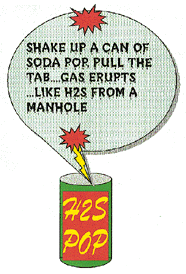Hydrogen Sulfide Kills
By Mary Gayman
Forewarned is forearmed
Cities across the nation are required to provide sewer workers with special safety training on subjects such as proper use of tools, lifting, hazards from wastewater chemicals and "confined space" entry.
OSHA regulations require all sewer crews to have on hand a tri-detector to measure sewer gases in the manhole atmosphere prior to removal of the lid.
Training is also provided on rescue methods, in case of confined space accidents. Crews are instructed on the proper use of harnesses, hoists ladders and ropes. Each worker must always wear personal safety gear such as hard hats, steel-toed boots, back braces, gloves, and safety glasses.
Three invisible killers in sewers
Three types of invisible dangers can be found in sewer manholes or "confined space" within the system. They are:
- Explosive gases
- Lack of oxygen
- Hydrogen sulfide gas
Methane gas, generated by decomposing sewage, is lighter than air and tends to rise in the manhole. Once the lid is lifted, the gas rises quickly into the atmosphere and is dissipated in strength.
Big bang
Methane is one of several volatile gases found in sewers. It is generated from the sewage itself and so is more likely to be present than those discharged by industrial users.
Volatile gases can be ignited by a small spark, causing violent explosions.
In Louisville, Kentucky hexane accidentally overflowed into the main from a stripping operation. Gas from the hexane rose through the pick holes and gathered under an overpass in the road. A spark from the catalytic converter of a passing car set off a huge explosion which caused a 35-foot deep crater to open up under the car, which miraculously lit upright in the crater. The startled occupants, who received only minor injuries, emerged to find themselves stranded in the sinkhole, which marked the beginning of a gash averaging 17 feet in depth for a distance of nearly 7 miles through Louisville streets. (For full details look for my upcoming article "Spectacular sewer collapses and explosions.")
Hydrogen sulfide "soda can" effect kills!
Ever shake up a soda pop and then pull the tab?
 When the gases in the soda get "all shook up," they explode from the opening in a huge upward force. When standing sewage is suddenly "shook up" by releasing a plug, by turning on a pump, or when the sewage is released into a "drop" manhole, gases released may well reach fatal levels.
When the gases in the soda get "all shook up," they explode from the opening in a huge upward force. When standing sewage is suddenly "shook up" by releasing a plug, by turning on a pump, or when the sewage is released into a "drop" manhole, gases released may well reach fatal levels.
Those who are at the first opening in the system can be enveloped in a lethal cloud above the manhole level.
Hydrogen sulfide is generated in the flow when sewage is allowed to stand for long period and become stagnant or septic. In these anaerobic conditions the sewage can contain up to 6000 parts per million.
Hydrogen sulfide (H2S) gas is normally heavier than air, but when agitated, it can erupt from the confines of the pipe in levels of toxicity which paralyze the lungs.
OSHA warns that levels of 300 ppm cause the olfactory nerve to lose sensitivity. At first a "rotten egg" odor is detected but on the second or third breath, the odor is no longer noticed. At 600 ppm, breathing is inhibited, as the lungs fill with the gas.
At higher levels, paralysis of the lungs occursÑonly very fast action could save the victim by removal from the gas area and immediate application of oxygen.
The grim reaper at our door -- H2S gas killed our friends
Our two sons, Todd and Brett, discovered their friends and co-workers, Michael Skinner and Horatio Bonahora in the bottom of a manhole on January 13, 1984. The cause of their deaths has led to continuing efforts at educating others on little known aspects of H2S dangers.
Four men from our company were setting up to televise a line under a river near Ventura, California. The men were experiencing problems in running the jetter through a long reach of 18" line to tag for the camera.
A laborer, working for our client, was sent upstream to restore the flow to the line to allow for a float tag. The nearest manhole was 750 above our work site. Nearly 2,000 feet beyond that, two large diameter pipes converged at a manhole. These lines had been bypassed and plugged for nearly two months to facilitate the repair work we were assigned to inspect.
Hidden in the trees, around the bend of the river, was a lake of raw sewage created from the overflowing line. In all, there was about 2,750 feet of 18- and 15-inch pipe filled with septic sewage behind the plugs. It had been standing in the pipes for at least 40 days.
Apparently the laborer, a bulldozer operatorÕs assistant, entered the manhole and unscrewed a 2" thru-pipe in the inflated plugs and closed the lid on the manhole.
Horatio, stationed at the only open manhole below the plugs, was watching for a tag line to come through. He was well versed in this simple task, and was properly set up to feed the yellow propylene tag line float into the flow. Michael was near at hand, ready to begin pulling back the camera cable, once attached to the line.
It was a crisp, clear, sunny day.
At the downstream manhole, our sons Todd and Brett noticed a buildup of water in the manhole. Todd realized water appeared to be backing up from a restriction just downstream of their position. He climbed over the rip-rap of rocks on the river bend and discovered two men attempting to remove a a sand trap from the line. The trap had been placed there to prevent sand and rock from being carried down stream to the treatment plant while a pipe under the river was replaced.
It was evident that the tag would not reach the equipment hookup if the manhole was surcharged.
Meanwhile, a far more serious situation was developing upstream. As water backed up toward Horatio, gases which were traveling along ahead of the flow were now being "squeezed" between the converging flows.
Horatio was standing directly over the only "chimney" from which the gas could escape. As the flows converged, deadly hydrogen sulfide gas was forced from the manhole into the atmosphere, enveloping Horatio in a "mushroom cloud" of lethal gas. He fell forward, paralyzed, directly into the channel of the nine-foot deep manhole. Head injuries from the fall alone would have killed him.
Most rescuers die, too
Ignoring all of the training and warnings about "second man" fatalities, Michael lowered himself into the manhole to "rescue" his friend, Horatio. First, he signaled with a loud whistle to bring help. Michael knew there were no rungs in the manhole, and likely his sense of smell was deadened to the danger. Once inside, he had no way out.
Brett heard the whistle, ran over the open railway trestle, but found no sign of the two men. The only outward sign was the yellow tag rope still dangling into the hole. Brett recalls that just as he looked down, Michael looked up, then fell backwards over HoratioÕs body.
Even after Todd ran for miles to phone, emergency equipment was unable to reach the site. When a helicopter and medics finally arrived, Horatio was long gone and Michael was brain dead.
MichaelÕs family flew to his bedside, where his heart was kept alive by machinery. His mother and younger brother said good-bye, and following MichaelÕs previously expressed wishes, released him as an organ donor.
Five received new life in MichaelÕs death.
Nine others in California succumb to H2S in two other incidents
In the previous months, five men died just a few feet from the front door of a treatment plant when they gathered to inspect the first flow into a new sampling manhole. When the pumps were restarted, gas released from the stagnant sewage enveloped all in a shroud of death at 6,000 ppm.
At an oceanside treatment plant, four men, assigned to jackhammer open the top of a shallow trunk line, collapsed and died when the roiling flow in the line released gas upward through the opening made to test for deterioration of the concrete.
Confined space rules don't apply; danger remains unregulated
OSHA defines a manhole as a confined space and writes extensive regulations on such spaces.
Strangely, the definition of "confined space" does not apply in cases where H2S or other gases rise into the free atmosphere above the level of the lid.
It has been suggested that dangers from H2S rising to street level might be controlled by those regulations which provide for traffic safety!
 Thus, the discussion of these dangers has remained "up in the air" for more than 13 years.
Thus, the discussion of these dangers has remained "up in the air" for more than 13 years.
Since each state may chose to add regulations or training on items of their concern, it appears that the job of informing others of these dangers will remain for a long time in bureaucratic limbo.
It is hoped that this article and a series of talks we provide for public agency personnel will help bring recognition to this problem.
The National Association of Sewer Service Contractors (NASSCO) kept careful statistics on sewer accidents and deaths for at least 15 years but has abandoned that activity.
Readers wishing to have further details may reach the author at 1-800-372-9637.
Republished courtesy of Pumper Magazine, a publication of Cole Publishing Inc., POB 220, Three Lakes WI 54562, tel. 800-257-7222 or 715-546-3346, and author Mary Gayman.
 Return to the Wastewater area of the SwopNet Engineering Databank. There you will find other articles by Mary Gayman, and the Thomas Crapper photo page.
Return to the Wastewater area of the SwopNet Engineering Databank. There you will find other articles by Mary Gayman, and the Thomas Crapper photo page.
 When the gases in the soda get "all shook up," they explode from the opening in a huge upward force. When standing sewage is suddenly "shook up" by releasing a plug, by turning on a pump, or when the sewage is released into a "drop" manhole, gases released may well reach fatal levels.
When the gases in the soda get "all shook up," they explode from the opening in a huge upward force. When standing sewage is suddenly "shook up" by releasing a plug, by turning on a pump, or when the sewage is released into a "drop" manhole, gases released may well reach fatal levels. Thus, the discussion of these dangers has remained "up in the air" for more than 13 years.
Thus, the discussion of these dangers has remained "up in the air" for more than 13 years.